Related Research Articles

The resplendent quetzal is a small bird found in southern Mexico and Central America, with two recognized subspecies, P. m. mocinno and P. m. costaricensis. These animals live in tropical forests, particularly montane cloud forests and they are part of the Trogonidae family. Like other quetzals, the resplendent is omnivorous; its diet mainly consists of fruits of the Lauraceae family, but it occasionally also preys on insects, lizards, frogs and snails.

The white hawk is a bird of prey breeding in the tropical New World of the family Accipitridae. Though it is commonly placed in the subfamily Buteoninae, the validity of this group is doubtful and currently under review.
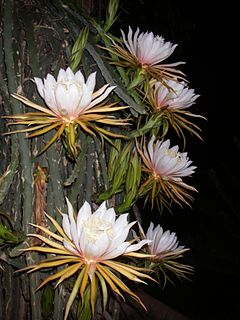
Hylocereus is a former genus of epiphytic cacti, often referred to as night-blooming cactus. Several species previously placed in the genus have large edible fruits, which are known as pitayas, pitahayas or dragonfruits. In 2017, a molecular phylogenetic study confirmed an earlier finding that the genus Hylocereus was nested within Selenicereus, so all the species of Hylocereus were transferred to Selenicereus.

Cherrie's tanager is a medium-sized passerine bird. This tanager is a resident breeder in the Pacific lowlands of Costa Rica and western Panama. This bird was formerly known as the scarlet-rumped tanager, but was split as a separate species from the Caribbean form, which was itself renamed as Passerini's tanager, Ramphocelus passerinii. While most authorities have accepted this split, there are notable exceptions. It was lumped back into the scarlet-rumped tanager in 2018.

Selenicereus costaricensis, synonym Hylocereus costaricensis, known as the Costa Rican pitahaya or Costa Rica nightblooming cactus, is a cactus species native to Costa Rica, Panama and Nicaragua. The species is grown commercially for its fruit, called pitaya or pitahaya, but is also an impressive ornamental vine with huge flowers. The species may not be distinct from Selenicereus monacanthus.
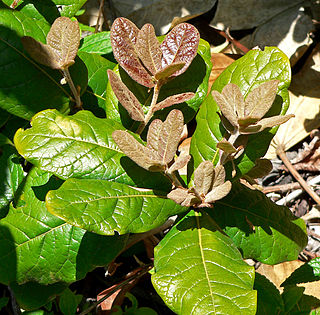
Quercus costaricensis is a species of oak native to Central America. It is often found with Quercus copeyensis in the upper montane forests, to 3,100 metres elevation. The leaves are tough and leathery with a short petiole and toothed margin. Wind is the primary pollinator. Squirrels are their main seed predator but also their main disperser as they commonly lose their buried seeds.
Quercus copeyensis is a species of oak endemic to the Talamancan montane forests of Costa Rica and Panama. It is commonly called Panamanian oak.

The blue-fronted parrotlet is also known as the red-winged parrotlet. It is a parrot in N. South America from E. Panama down the west coastal Andes to Peru, with a second population around and south of Lake Maracaibo. It is 15 cm, green with a short tail, blue forehead with narrow band of red under eye, red shoulders and leading edge of underwing, and the remaining underwing coverts yellow. Edges of tail also yellowish.
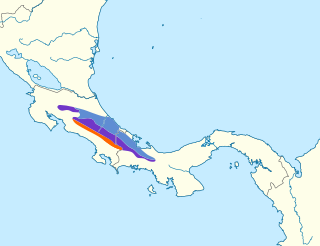
The red-fronted parrotlet is a parrot in Central America in Costa Rica and Panama. It is 15 cm, green with a short tail, red forehead, lores, and under eye, red shoulders and leading edge of underwing, and the remaining underwing coverts yellow. Edges of tail also yellowish.
Cherrie's pocket gopher is a species of rodent in the family Geomyidae. It is found in Honduras, Nicaragua, and Costa Rica. It is threatened by habitat loss. Some authors classify it in the genus Orthogeomys, but recent research has allowed this and its related species to be classified in the genus Heterogeomys.

A pitaya or pitahaya is the fruit of several different cactus species indigenous to the Americas. Pitaya usually refers to fruit of the genus Stenocereus, while pitahaya or dragon fruit refers to fruit of the genus Selenicereus, both in the family Cactaceae. Dragon fruit is cultivated in Peru, Mexico, South Asia, Southeast Asia, East Asia, the United States, the Caribbean, Australia, Mesoamerica and throughout tropical and subtropical regions of the world.
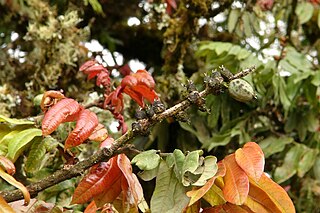
Alfaroa costaricensis, also known as campano chile, chiciscua, gaulin, gavilán Colorado, or gavilancillo, is nut bearing timber tree in the Juglandaceae family. It is native to the Neotropics, from Mexico, through Central America to Colombia.
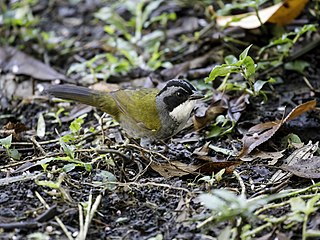
The Costa Rican brushfinch or grey-striped brushfinch is a species of bird in the family Passerellidae. It lives in the undergrowth of humid forest, especially near the edges, at altitudes of 300 to 1,200 metres in Panama and Costa Rica.
Angiostrongylus costaricensis is a species of parasitic nematode and is the causative agent of abdominal angiostrongyliasis in humans. It occurs in Latin America and the Caribbean.

The black-headed brushfinch is a species of bird in the family Passerellidae. It lives in the undergrowth of humid forest, especially near edges, at altitudes of 300 to 1,200 metres in Colombia and Panama.
The Costa Rica worm snake is a species of snake in the Typhlopidae family.

Comarostaphylis arbutoides is a species of shrub in the heath family. Its range extends from central Mexico south to Guatemala, Honduras, Nicaragua, Costa Rica, and western Panama. It is found in oak and pine forests in mountainous locations, and on the summits of Central American volcanoes, at elevations from 1,350 to 3,800 m. There are two subspecies: arbutoides, distinguished by the presence of a rust-colored tomentum on the leaf underside, and costaricensis which lacks the tomentum.

Beloglottis costaricensis is a terrestrial species of orchid. It has a wide distribution, reported from Mexico, Central America, the West Indies, South America, and Dade County Florida.
Listeria costaricensis is a species of bacterium of the genus Listeria. It is a Gram-stain-positive, rod-shaped bacterium, non-spore-forming and facultatively anaerobic. Colonies are opaque, yellow-pigmented, with a flat shape and entire margin on BHI. Growth occurs at 22–42 °C, with optimal growth at 30–37 °C. It has motility at 37 °C. The bacteria is negative for catalase, haemolysis and nitrite reduction. It can be differentiated from other species of the genus Listeria by the absence of catalase reaction, production of acid from potassium 5-ketogluconate and production of a yellow pigment on BHI. It is presumably non-pathongenic due to the lack of haemolysis and pathogenicity genes on its genome.
References
- ↑ Biolib.cz - Cicatrisestoloides costaricensis. Retrieved on 8 September 2014.